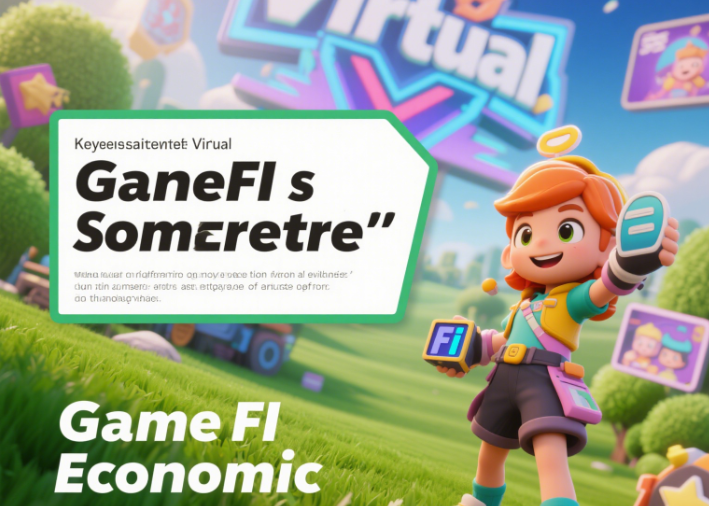The Virtual GameFi Economy is reshaping the intersection of gaming, blockchain, and decentralized finance (DeFi), offering players unprecedented opportunities to earn, own, and trade digital assets. By integrating non-fungible tokens (NFTs), decentralized governance, and play-to-earn (P2E) models, this ecosystem is transforming games into dynamic virtual economies where users can monetize their skills and creativity. This article explores the evolution of GameFi, its technical foundations, economic models, challenges, and future trends, with insights to help investors and gamers navigate this rapidly expanding landscape.
1. The Rise of GameFi: From Niche to Mainstream
GameFi, short for “Game Finance,” emerged in 2021 with the explosive success of titles like Axie Infinity, which allowed players to earn cryptocurrency by breeding and battling digital pets. Since then, the sector has grown exponentially, driven by blockchain technology’s ability to enable true ownership of in-game assets. By 2025, the global GameFi market is projected to reach $126.17 billion with a compound annual growth rate (CAGR) of 27.13% , attracting millions of users seeking both entertainment and financial rewards.
Key drivers of this growth include:
- NFT Integration: NFTs represent unique in-game items (e.g., weapons, land, avatars), allowing players to trade them on decentralized exchanges (DEXs) like OpenSea.
- Play-to-Earn Models: Games like Stepn and Illuvium reward players with tokens for completing tasks or achieving milestones, creating new income streams.
- Decentralized Governance: DAOs (Decentralized Autonomous Organizations) like Yield Guild Games (YGG) empower players to vote on game updates and tokenomics.
However, GameFi’s early growth was marred by challenges such as poor user experience (UX), complex wallet setups, and unsustainable tokenomics. Projects like Hamster Kombat saw massive user surges but struggled with retention due to hyperinflation and shallow gameplay . To address these issues, developers are now prioritizing immersive storytelling, dynamic reward systems, and cross-platform interoperability.
2. Technical Foundations: Blockchain, NFTs, and DeFi
The Virtual GameFi Economy relies on three core technologies:
Blockchain:
Blockchains like Ethereum, Solana, and Immutable X provide the infrastructure for transparent, tamper-proof asset ownership. Layer 2 solutions (e.g., Polygon, Arbitrum) reduce gas fees and improve scalability, making transactions faster and cheaper .
NFTs:
NFTs are the backbone of GameFi’s digital asset economy. They enable players to:
- Own Unique Items: In Decentraland, players can buy virtual land as NFTs and build experiences.
- Earn Royalties: Creators of NFT skins or mods earn a percentage of secondary sales.
- Participate in Governance: NFTs often grant voting rights in DAOs.
DeFi Integration:
DeFi protocols like Aave and Uniswap are being integrated into games to offer:
- Liquidity Pools: Players can stake tokens to earn rewards.
- Yield Farming: Games like DeFi Kingdoms allow users to farm tokens through in-game activities.
- Cross-Chain Bridges: Solutions like BitVM Bridge enable seamless asset transfers between blockchains .
3. Economic Models: Balancing Play and Profit
GameFi’s economic sustainability hinges on well-designed tokenomics. Successful projects use multi-token systems to balance rewards and scarcity. For example:
- Illuvium (ILV): Combines governance tokens (ILV) with in-game currency (iLP) to distribute platform fees to stakers .
- Big Time (BIGTIME): Uses dynamic token distribution to adjust rewards based on player activity, ensuring long-term engagement .
Challenges in Tokenomics:
- Inflation: Over-supply of tokens devalues rewards, as seen in Hamster Kombat .
- Centralization: Some projects retain control over token supply, undermining decentralization.
- Speculation: Players often prioritize short-term gains over gameplay, harming retention.
To address these issues, developers are adopting adaptive reward systems and community-driven governance. For instance, Axie Infinity: Origins plans to distribute transaction fees to AXS holders, aligning player and investor interests .

4. The Future of GameFi: Trends Shaping the Virtual Economy
AI and Generative Content:
AI is revolutionizing game development. Tools like Scenario allow creators to generate high-quality assets with text prompts, while Mirror World uses AI to create interactive NFT characters that adapt to player behavior . These innovations reduce development costs and enable user-generated content (UGC), fostering creativity and engagement.
AR/VR Integration:
Augmented reality (AR) and virtual reality (VR) are enhancing immersion. Projects like Calo Indoor combine AR workouts with GameFi, rewarding users for physical activity . In VR, platforms like Decentraland host virtual concerts and events, blurring the lines between the digital and physical worlds.
Real-World Asset (RWA) Tokenization:
GameFi is expanding beyond virtual assets. Projects like Beyond Gaming’s BDG tokenize real-world assets (e.g., real estate, gold), allowing players to invest in and trade these assets within games . This integration bridges traditional finance and Web3, creating new revenue streams.
Mainstream Adoption:
Traditional gaming giants like Ubisoft and EA are entering GameFi, bringing AAA-quality graphics and storytelling. Meanwhile, regulatory frameworks in regions like Hong Kong are legitimizing RWA tokenization, boosting investor confidence .
5. Challenges and Solutions
Despite its growth, GameFi faces hurdles:
- Technical Complexity: Users struggle with crypto wallets and blockchain interactions. Simplified onboarding tools (e.g., social logins) and user-friendly interfaces are key.
- Regulatory Uncertainty: Governments are cracking down on unlicensed crypto activities. Projects must comply with securities laws and anti-money laundering (AML) regulations.
- Security Risks: Smart contract hacks and rug pulls deter users. Audits and decentralized insurance protocols like Nexus Mutual are critical.
Conclusion: Stay Ahead with Bitora’s GameFi Insights
The Virtual GameFi Economy is a frontier of innovation, offering endless possibilities for gamers, developers, and investors. As the ecosystem matures, staying informed about trends, projects, and market dynamics is essential. Bitora, your trusted source for real-time GameFi news and analysis, provides in-depth coverage of tokenomics, regulatory updates, and emerging opportunities. Visit Bitora to unlock the future of play, ownership, and profit in the metaverse.









Leave A Reply